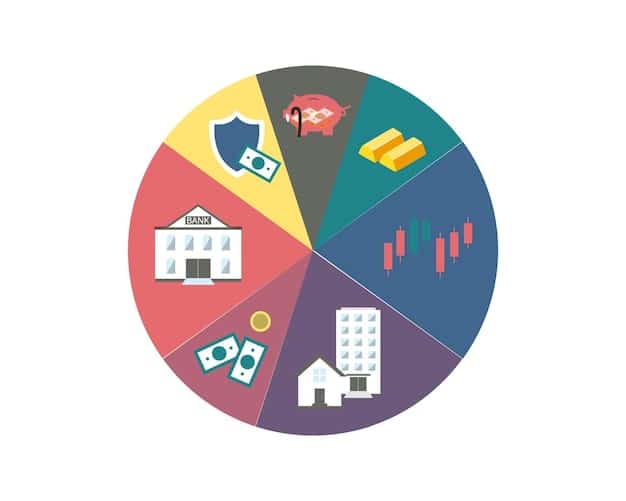Rebalance Your Portfolio for 2025: A Step-by-Step Guide

How to Rebalance Your Portfolio for 2025: A Step-by-Step Guide to Maintaining Your Target Asset Allocation involves periodically adjusting your investment holdings to align with your desired risk tolerance and investment goals, ensuring your portfolio remains optimized for long-term financial success.
Is your portfolio ready for 2025? Market fluctuations can throw your asset allocation off balance. Learn how to rebalance your portfolio for 2025: a step-by-step guide to maintaining your target asset allocation, so you can stay on track toward your financial goals.
Why Rebalancing Your Portfolio Matters
Rebalancing your investment portfolio is a crucial practice for maintaining your desired risk level and achieving your long-term financial goals. Without periodic adjustments, your asset allocation can drift away from your initial targets due to varying market performance of different asset classes. This drift can expose you to unintended risks and potentially hinder your portfolio’s ability to deliver the returns you expect.
Think of your portfolio as a garden. Just like a gardener needs to prune and water plants to keep them healthy, you need to rebalance your investments to ensure they continue to thrive. Here’s why it is so important:
Maintaining Your Risk Tolerance
Your risk tolerance is a key factor in determining your ideal asset allocation. Rebalancing helps ensure your portfolio’s risk profile remains aligned with your comfort level.
Staying on Track with Your Financial Goals
Rebalancing helps keep you on track to meet your financial goals, such as retirement, education funding, or purchasing a home.
Capturing Profits and Buying Low
Rebalancing involves selling assets that have performed well and buying assets that have underperformed. This “buy low, sell high” approach can boost your returns over the long term.
- Risk Management: Prevents overexposure to certain asset classes.
- Goal Alignment: Keeps your investments aligned with your financial objectives.
- Disciplined Investing: Encourages selling high and buying low.
- Long-Term Performance: Optimizes returns over time.
In summary, rebalancing your portfolio is not just about maintaining a static allocation; it’s about proactively managing risk and ensuring your investments work in harmony to achieve your financial goals. Regular reviews and adjustments are key to a well-balanced and successful investment strategy. By understanding the importance and benefits of rebalancing, you can make informed decisions to optimize your portfolio’s performance and stay on the path to financial security.
Step 1: Define Your Target Asset Allocation
Before you can rebalance your portfolio, you need to clearly define your target asset allocation. This is the percentage breakdown of your investments across different asset classes, such as stocks, bonds, and real estate. Your target allocation should reflect your risk tolerance, time horizon, and financial goals. Let’s break it down.
Understanding your risk profile and investment timeline will allow you to build a well-balanced asset allocation strategy. Here’s what you need to do:
Assess Your Risk Tolerance
Determine how comfortable you are with market fluctuations and potential losses. Conservative investors typically prefer a higher allocation to bonds, while aggressive investors favor stocks.
Determine Your Time Horizon
Consider the length of time you have until you need to access your investment funds. A longer time horizon allows for more aggressive strategies, as there is more time to recover from market downturns.
Set Your Financial Goals
Define your financial goals, such as retirement, education funding, or buying a home. Your goals will influence the types of assets you choose and the returns you aim to achieve.

Consider the following sample allocations:
- Conservative: 30% Stocks, 70% Bonds
- Moderate: 60% Stocks, 40% Bonds
- Aggressive: 80% Stocks, 20% Bonds
By defining your target asset allocation, you set the foundation for a well-balanced investment strategy that aligns with your goals and risk tolerance. Once you have this clear picture, you can move on to the next steps in the rebalancing process with confidence, knowing that your decisions are grounded in a solid understanding of your financial objectives and risk profile.
Step 2: Review Your Current Portfolio Allocation
Once you’ve established your target asset allocation, the next step is to assess your current portfolio. This involves determining the actual percentage breakdown of your investments across different asset classes. Comparing this breakdown to your target allocation will highlight any discrepancies that need to be addressed through rebalancing. Let’s see how we can do this properly.
To get a clear picture of your portfolio’s current state, you need to:
Gather Your Account Statements
Collect statements from all your investment accounts, including brokerage accounts, retirement accounts, and any other investment holdings.
Categorize Your Investments
Classify each investment into its respective asset class, such as stocks, bonds, real estate, and cash. This categorization is crucial for an accurate assessment.
Calculate Current Allocation Percentages
Determine the percentage of your total portfolio that each asset class represents. This calculation will reveal how your current allocation compares to your target.
Let’s look at some examples:
- Stocks: 65%
- Bonds: 25%
- Real Estate: 10%
Once you’ve determined your portfolio’s current allocation, you can compare it to your target allocation to identify areas that need adjustment. This comparison will serve as the basis for your rebalancing strategy, ensuring that your portfolio aligns with your desired risk level and financial goals. Careful analysis and attention to detail in this step are essential for effective portfolio management.
Step 3: Calculate the Necessary Adjustments
After reviewing your current portfolio allocation and comparing it to your target, the next step is to calculate the necessary adjustments needed to bring your portfolio back into balance. This involves determining which assets need to be bought or sold to realign your allocation with your financial goals and desired risk tolerance. How is this done?
Here’s how to calculate the adjustments:
Determine the Difference
Calculate the difference between your current allocation percentage and your target allocation percentage for each asset class. This will show you how much each asset class needs to be adjusted.
Calculate the Dollar Amount
Multiply the percentage difference by the total value of your portfolio to determine the dollar amount to be bought or sold for each asset class.
Consider Transaction Costs
Factor in transaction costs, such as brokerage fees and taxes, when calculating the adjustments. These costs can impact the overall effectiveness of your rebalancing efforts.
Here are some things to take into account:
- Asset Class Variance: Identify which assets have deviated most from their target.
- Rebalancing Threshold: Set a threshold (e.g., 5%) to trigger rebalancing.
- Tax Implications: Understand the tax consequences of selling assets.
By calculating the necessary adjustments, you gain a clear understanding of the specific actions required to bring your portfolio back into alignment with your target allocation. This calculation ensures that your rebalancing efforts are precise and effective, helping you stay on track toward achieving your financial goals while maintaining your desired risk level.
Step 4: Execute Your Rebalancing Strategy
With the necessary adjustments now calculated, it’s time to execute your rebalancing strategy. This involves buying and selling assets in your portfolio to align with your target asset allocation. Implementing this step effectively is crucial for maintaining your desired risk level and achieving your financial goals. But what is the best approach?
Here are some strategies for executing your rebalancing plan:
Sell Over-allocated Assets
Sell assets that have increased in value and are now over-allocated in your portfolio. This helps you capture profits and reduce your exposure to those assets.
Buy Under-allocated Assets
Purchase assets that have decreased in value and are now under-allocated in your portfolio. This allows you to buy low and increase your exposure to those assets.
Use New Contributions
Direct new contributions to under-allocated assets to gradually rebalance your portfolio over time. This approach can be tax-efficient and minimize transaction costs.

Let’s consider some other approaches:
- Tax-Advantaged Accounts: Prioritize rebalancing in tax-advantaged accounts.
- Dollar-Cost Averaging: Invest fixed amounts regularly to reduce market timing risk.
- Automated Rebalancing: Utilize robo-advisors for automated rebalancing.
Executing your rebalancing strategy is not just a mechanical process; it requires careful consideration of market conditions, tax implications, and overall investment goals. By implementing these strategies effectively, you can maintain a well-balanced portfolio that aligns with your risk tolerance and supports your long-term financial objectives.
Step 5: Monitor and Review Regularly
Rebalancing your portfolio is not a one-time event; it’s an ongoing process that requires regular monitoring and review. Market conditions and your personal circumstances can change over time, so it’s important to periodically reassess your portfolio and make necessary adjustments. Let’s dive in!
To effectively monitor your portfolio, consider the following:
Set a Review Schedule
Establish a regular schedule for reviewing your portfolio, such as quarterly or annually. This ensures that you stay on top of any significant deviations from your target allocation.
Track Performance
Monitor the performance of your assets and identify any trends or patterns that may indicate the need for adjustments.
Adjust for Life Changes
Consider any changes in your personal circumstances, such as income, expenses, or risk tolerance, and adjust your portfolio accordingly.
Remember to consider these helpful points:
- Market Volatility: Be prepared to rebalance more frequently during volatile periods.
- Portfolio Drift: Monitor how far your portfolio has drifted from its target.
- Long-Term Goals: Keep your long-term financial goals in mind when making adjustments.
Regular monitoring and review are essential components of successful portfolio management. By staying informed, proactive, and responsive to market developments, you can ensure that your portfolio remains aligned with your financial objectives and risk tolerance, positioning you for long-term success. This ongoing process is key to achieving your financial goals.
Step 6: Consider Tax Implications
When rebalancing your portfolio, it’s essential to consider the tax implications of your actions. Selling assets can trigger capital gains taxes, which can reduce your overall returns. Understanding these tax considerations and implementing tax-efficient strategies can help you minimize your tax burden and maximize your investment gains. Here’s how:
Here’s what you need to keep in mind to consider tax implications:
Tax-Advantaged Accounts
Prioritize rebalancing in tax-advantaged accounts, such as 401(k)s and IRAs, where gains are either tax-deferred or tax-free.
Tax-Loss Harvesting
Use tax-loss harvesting to offset capital gains by selling assets that have experienced losses. This can help reduce your overall tax liability.
Long-Term vs. Short-Term Gains
Be aware of the difference between long-term and short-term capital gains tax rates. Long-term gains, from assets held for more than a year, are typically taxed at a lower rate.
When rebalancing, consider these strategies:
- Asset Location: Hold tax-inefficient assets in tax-advantaged accounts.
- Wash Sale Rule: Avoid repurchasing sold assets within 30 days to claim a loss.
- Consult a Professional: Seek advice from a tax professional to optimize your strategy.
By carefully considering the tax implications of your rebalancing strategy, you can minimize your tax burden and improve your overall investment returns. Tax-efficient planning is a critical component of successful portfolio management and can help you achieve your financial goals more effectively. Don’t overlook the tax consequences of your rebalancing activities.
| Key Point | Brief Description |
|---|---|
| 🎯 Define Target Allocation | Establish your desired asset mix based on risk and goals. |
| 📊 Review Current Allocation | Assess your portfolio’s current asset distribution. |
| 🧮 Calculate Adjustments | Determine necessary buys and sells to realign. |
| 💰 Tax Efficiency | Prioritize tax-advantaged accounts and strategies. |
Frequently Asked Questions
▼
Asset allocation is the process of dividing your investment portfolio among different asset classes, such as stocks, bonds, and real estate. The goal is to balance risk and return to meet your financial goals.
▼
A common guideline is to rebalance annually or when your asset allocation deviates significantly (e.g., 5%) from your target. However, the frequency can depend on market volatility and your specific circumstances.
▼
Selling assets to rebalance can trigger capital gains taxes. It’s best to rebalance in tax-advantaged accounts or use tax-loss harvesting to minimize your tax burden and be more efficient.
▼
Yes, robo-advisors offer automated rebalancing services that can help you maintain your target allocation without manual intervention. These platforms handle the buying and selling of assets.
▼
If your risk tolerance changes, reassess your target asset allocation. If you become more risk-averse, shift more of your portfolio to lower-risk assets like bonds.
Conclusion
In conclusion, understanding how to rebalance your portfolio for 2025: a step-by-step guide to maintaining your target asset allocation is essential for sustaining long-term financial health. By defining your target allocation, reviewing your current portfolio, calculating necessary adjustments, executing your strategy, monitoring regularly, and considering tax implications, you can navigate the market with confidence. Regular rebalancing ensures your investments stay aligned with your goals, mitigates risk, and maximizes returns, paving the way for a secure financial future.





